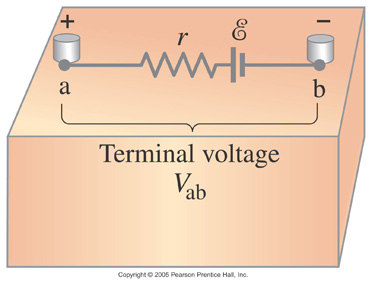Electromotive Force (EMF)
Recall that to have current in a circuit; you need a battery or other device that provides a potential difference (electrical energy). Such a device is called a source and it provides an emf. Emf stands for electromotive force, though it is not a force. Most scientists use the abbreviation to eliminate any confusion with a force that is measured in Newtons. The potential difference between the terminals of a battery or source when there is NO current flowing through it is called the emf of that source. It is represented by the symbol ξ, xi. (Don’t confuse that symbol, however, with E for electric field.)

A battery is a source of emf (nearly constant), but it is not the source of constant current. The current that flows from a battery depends on the resistance in the circuit that is attached to it. A battery or source also has some internal resistance as well. When current flows through the battery, you can measure the terminal voltage: ![]() . If there is no current flowing through the battery, then the terminal voltage is equal to the emf of the battery. If there is a current flowing through the battery, the internal resistance can be measured and has a direct effect on the voltage:
. If there is no current flowing through the battery, then the terminal voltage is equal to the emf of the battery. If there is a current flowing through the battery, the internal resistance can be measured and has a direct effect on the voltage:
![]()
Where the terminal voltage is found by subtracting the voltage loss due to internal resistance (Ir) from the original emf (ξ). When problem solving, assume that the internal resistance of a battery is negligible unless stated otherwise. Most batteries have extremely low internal resistance.